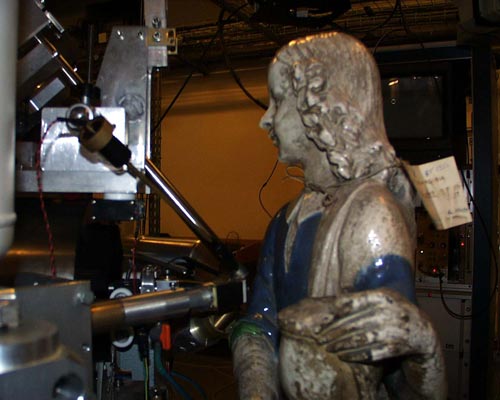The know how of artisans in the past
Many important clues about the fabrication technique of heritage objects can be found by simply identifying the materials used to produce the work. However the details of the way the elements are displayed on the surface or in depth allow them to go further and often give a decisive indication.

Analysis of a Renaissance statuette
This glazed terracotta statuette comes from the Della Robia workshop, a dynasty of Renaissance artists. On the photograp, the statuette is exposed to a particle beam extracted from the AGLAE accelerator. The aim of the analysis is, by identifying the materials used on its surface of the statuette, to attribute the statuette to a member of the Della Robia dynasty.
© LRMF
The PIXE method has been used to determine welding techniques in antique and medieval silverware. A second method (the elastic scattering of protons and more recently of alpha particles) has been applied to the study of golden objects in order to determine the composition of golden alloys and the thickness of the gilt.
For example, the study of gold used for different parts of the crowns and crosses of the Guarrazar treasure near Toledo in Spain has produced information about the technique used for silverware at the time of the Visigoth Kings in the VIII century.
They have also been able to distinguish, the original parts from the modern parts which were introduced at the time of the restoration of the treasure shortly after its discovery (XIXth century). In their present state the crosses and crowns are not correctly matched.
The gold used in these jewels has been confirmed of a higher quality titre than the money that the Visigoth Kings used at that time.
Learn more
PIXE method